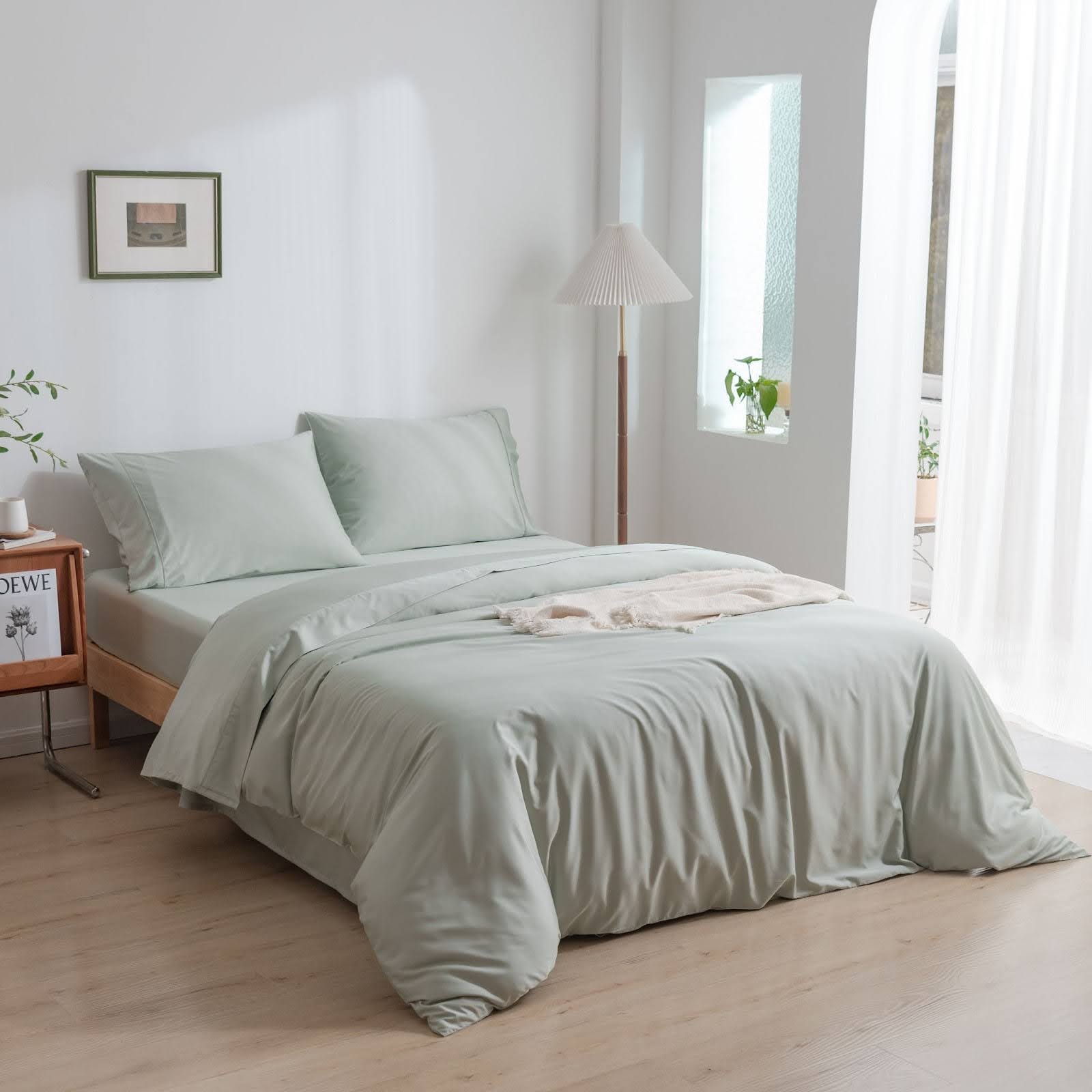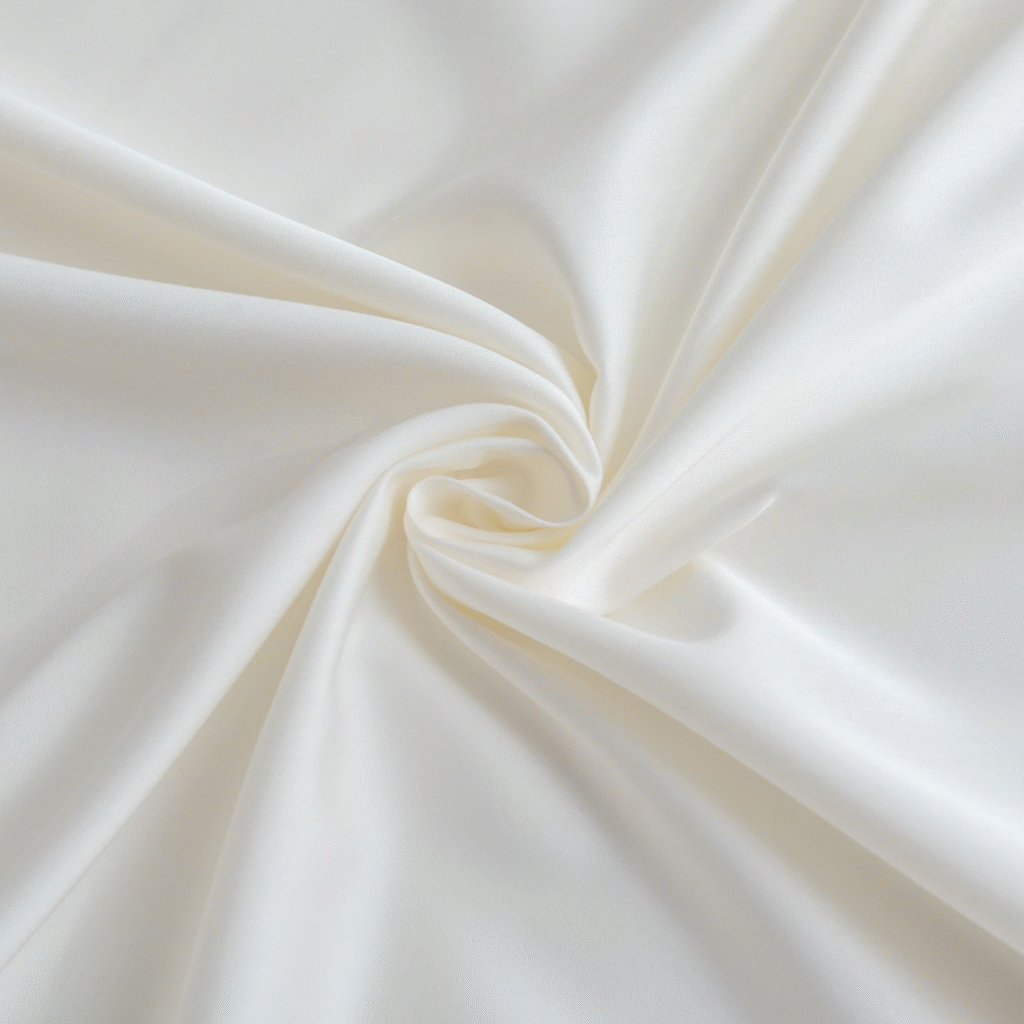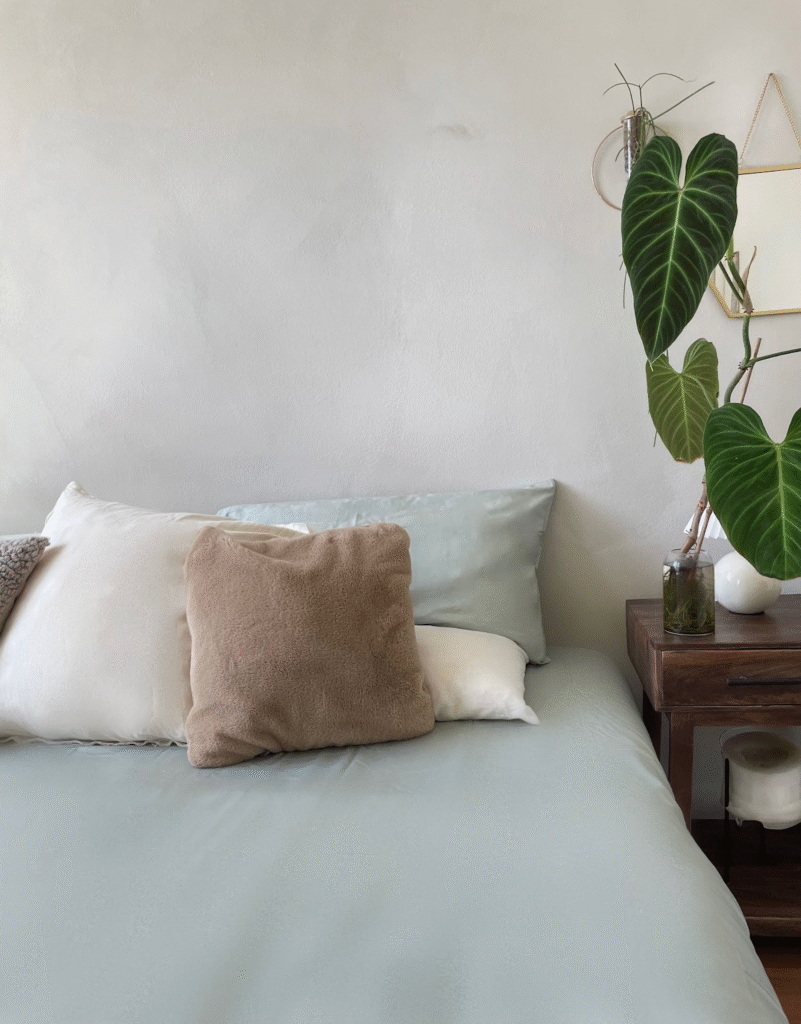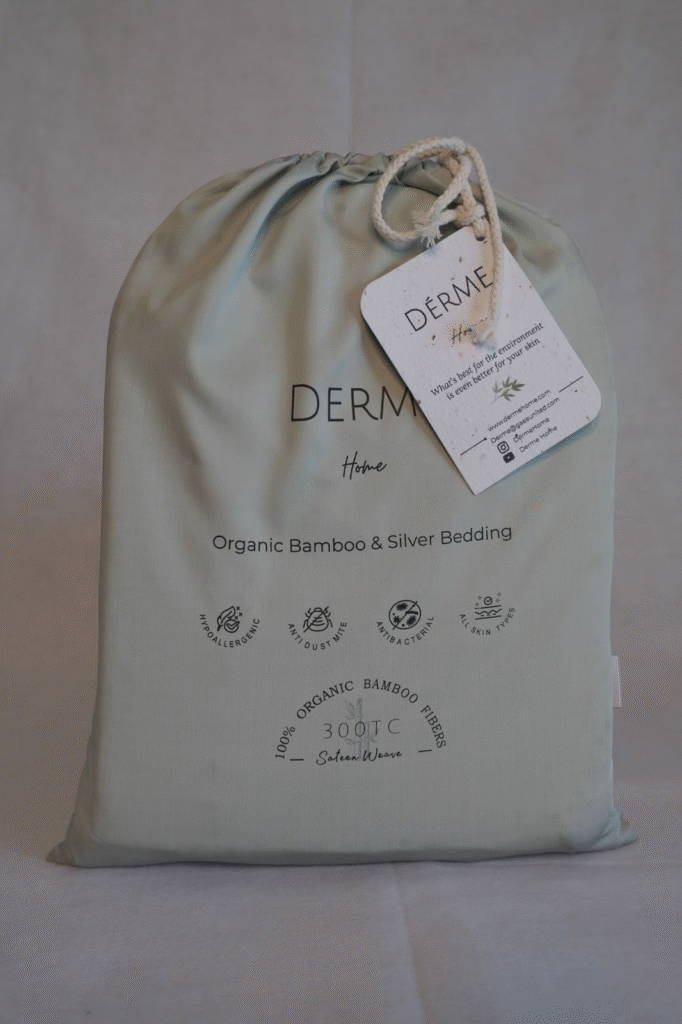Derme Home vs Coyuchi: Which Bedding Is Better for Your Skin and Sleep?

Is your pillow helping your skin, or working against it while you sleep?
Your face spends hours on that fabric. If breakouts hit your cheeks or jaw, what you sleep on matters. Acne forms when pores clog, and it commonly affects the face, neck, chest, and shoulders. (MedlinePlus)
Two brands take two very different routes. One builds bamboo pillowcases into the fabric itself. The other bets on certified organic cotton and a classic feel.
Dermatology guidance backs the basics here: breathable, moisture-moving fabrics cut friction and trapped sweat, two common triggers of acne mechanica. (American Academy of Dermatology, 2025)
Want to test the difference on your own skin? Try Derme Home today and use code PILLOWTALK20 to unlock an exclusive discount just for your first upgrade.
Derme Home vs Coyuchi: What Sets Them Apart
Derme Home
Bamboo bedding with bonded silver ions for a cleaner fabric surface. The brand states third-party testing shows a 99.99% reduction of bacteria on the fabric linked to acne. It also says the silver is permanent because it’s bonded into the fibers.
Coyuchi
GOTS-certified organic cotton sheets and pillowcases in different weaves (percale and sateen). Strong focus on organic inputs and responsible production.
How Acne-Fighting Pillowcases Protect Your Skin?
Your face lives on your pillow for hours. Oil, sweat, and normal skin microbes meet fabric every night. That is why the surface itself matters.
Derme Home’s promise is simple: keep the fabric cleaner between wash days with silver that reduces bacterial growth on the pillowcase. This does not replace your routine. It supports it.
If breakouts along the cheek and jaw are your pain point, this is a smart lever to pull first. Gentle routines work best: cleanse based on your skin type and avoid drying alcohol toners if you’re dry. (Harvard Health Publishing)
Coyuchi takes a different angle. It focuses on organic purity and breathable weaves. There is no antimicrobial claim. If you want GOTS and the comfort of organic cotton, Coyuchi fits that need well.
Ready to switch your pillowcase to one that supports clearer skin? Use PILLOWTALK20 at checkout and grab Derme Home’s Acne-Fighting Pillowcases today for a fresher, healthier sleep surface.
Bamboo vs Cotton Bedding: Feel and Comfort Compared

Derme Home: Bamboo + Silver, Sateen Feel
Bamboo gives a cool handfeel, easy drape, and a smooth glide across the skin. The silver is part of the fiber, so you don’t feel grit or stiffness. The brand notes the fabric stays soft and gets softer with washing. If you like silky movement and a soft, fluid drape, this feel works.
Coyuchi: Organic Cotton In Percale Or Sateen
Percale is crisp and tends to “tent” off the body, which boosts air flow and feels cooler for hot sleepers. Sateen is smoother, a touch warmer, and has a gentle sheen. Pick the weave based on your climate and preference for crisp vs. silky.
Derme Home for Acne Support vs Coyuchi for Organic Purity
If fabric freshness between washes is your main goal, Derme Home has a skin-first pitch. Its tests cite 99.99% bacterial reduction on fabric surfaces, including species tied to acne. That helps the pillow surface stay cleaner overnight, which supports breakout control.
If your top filter is certified organic cotton and gentle processing, Coyuchi is standard-first. GOTS is widely recognized and covers fiber, dyes, and processing rules. You get a familiar cotton feel with certification you can point to.
Acne is common at all ages, but no single fix works for everyone. Keep your routine consistent. (Mayo Clinic)
Which Bedding Stays Cooler at Night?
- Derme Home bamboo sateen feels cool to the touch and has a smooth, breathable hand. Great if you want glide and a less “crisp” feel on the skin.
- Coyuchi percale is the classic hot-sleeper pick thanks to a balanced weave that lifts off the skin for airflow. If you run hot and love that “fresh shirt” feel, this is your lane.
Durability and Easy Care: What to Expect
Silver that is woven into the fiber matters for long-term performance. Derme Home states its silver is bonded, so the benefits don’t wash out, and the fabric remains smooth. Follow normal washing guidance and rotate cases often for best results. At home, cleaning with soap and water is usually enough; you don’t need to disinfect unless someone is sick. (CDC)
Coyuchi cotton is easy to wash at home. The brand suggests cold wash on gentle, low tumble dry, and plant-based detergents.
Eco-Friendly Bedding: Bamboo Silver vs Organic Cotton
Derme Home centers bamboo plus permanent silver bonding. Bamboo is known for fast regrowth, and the brand presents silver bonding as a longer-lasting, less “wash-off” approach than topical finishes. If your goal is less laundering pressure and fabric that stays fresher between cycles, that angle makes sense.
Coyuchi leads with GOTS-certified organic cotton across many sheet lines. If certifications and organic inputs guide your purchases, this is a strong, easy-to-verify win.
Where to Start: Pillowcases or Full Sheet Sets?

Start with the item that touches your face the longest: the pillowcase.
- If acne is your main worry, start with Derme Home Acne prevention pillowcases. This is the highest-impact, lowest-risk step. Pair them with Bamboo sheets for acne as your next upgrade, so the full surface supports the same goal.
- If you want certified organic and a crisp, cool feel, start with Coyuchi percale. It’s the weave hot sleepers love. Add the matching fitted sheet and duvet for a full setup.
Start simple with pillowcases, or go for the full set with Derme Home’s Silver antibacterial sheets. Either way, your skin wins and your wallet does too when you apply PILLOWTALK20.
Science of Antimicrobial Bedding vs Organic Standards
- Antimicrobial bedding targets bacteria on the fabric. Derme Home cites third-party lab results showing a 99.99% reduction in its fabric. That can help the surface stay fresher overnight. It’s not a drug claim. It’s fabric hygiene. Silver can help keep fabric cleaner, but it’s not a medical acne treatment. (Science-Based Medicine)
- GOTS certification is about organic textile rules from farm to finish. Coyuchi relies on this system to show what’s in the processing. It’s trusted and easy to recognize.
If your top priority is the pillow surface that meets your skin, antimicrobial fabric support is compelling. If your top priority is the supply-chain standard, GOTS is your north star.
Simple Skincare Habits to Pair with Better Bedding
This is the part most people skip. Keep it simple and stay consistent.
- Cleanse at night: Use a gentle cleanser that your skin already tolerates. Pat dry with a clean towel.
- Moisturize smart: Use a light, non-greasy product that does not sting or clog. Less is more. If over-the-counter care hasn’t helped, see a dermatologist and bring a list of products you’ve tried. (Mayo Clinic)
- Hair matters: If you use hair oil or heavy products, wash the hairline well. Consider a soft hair wrap to keep product off the pillow.
- Phone and hands: Wipe your phone screen daily. Keep your hands away from your cheeks when you read or watch shows in bed.
- Rotate pillowcases often. Even with antimicrobial fabric, swap cases every few nights. If breakouts are active, change sooner. Fragrance is a common irritant; picking fragrance-free laundry products can cut flare-ups. (EWG Skin Deep)
- Work with your routine, not against it: A good pillowcase will not fix harsh scrubs, over-washing, or skipping moisture. Keep the routine gentle and steady.
- Build your bed slowly: Start with the pillowcase. Test for a week or two. Add sheets next if your skin feels calmer and mornings look better.
Bedding should have lower friction. It should not add steps. Derme Home aims to help on that front by keeping the fabric fresher. Coyuchi aims to help by keeping inputs simple and organic.
Bedding Texture and Sound: Small Details That Count
Some sleepers hate “sheet noise.” If that’s you, Derme Home’s bamboo sateen has low rustle and a fluid drape. If you love that hotel-fresh crispness, you’ll enjoy Coyuchi percale’s matte, structured hand.
Sateen from either brand will feel smoother and a bit warmer than percale. Pick by season or rotate both sets through the year.
Getting the Best Value from Your Bedding Choice
Think in terms of results per wash. If acne is your main problem, a pillowcase that helps the fabric surface stay cleaner gives you value on night one.
If organic inputs and traceable standards are your main goal, value shows up in peace of mind and consistent comfort. Both paths make sense. Your skin and your preferences decide.
Why Derme Home Is the Best Choice for Acne-Prone Sleepers?

| Your goal | Why Derme Home wins |
| Calm cheek/jaw breakouts | Silver in the fibers keeps the fabric fresher between washes |
| Keep the pillow clean longer | On-fabric freshness that doesn’t rinse off |
| Softer contact on skin | Smooth bamboo sateen lowers rub and tug |
| Whole-bed skin support | Extend the same freshness across the sheet surface |
| Cooler sleep with silky feel | Breathable bamboo feels cool to the touch |
| Simple, skin-friendly setup | Materials aligned with gentle, nightly care |
| Max antibacterial coverage | Sheet set designed for fabric-level bacteria control |
Quick Guide: Picking the Right Bedding for Your Needs
- Want built-in support for breakouts at the fabric level? Derme Home.
- Want certified organic cotton and classic weaves? Coyuchi.
- Prefer silky glide and low rustle? Derme Home bamboo sateen.
- Prefer crisp, cool sheets that lift off the skin? Coyuchi percale.
- Want to start small and see a fast difference? Swap the pillowcase first.
- Want a full-bed match? Expand to sheets and duvet once you like the feel and results.
Final Verdict
If skin is the priority, end the search here. Derme Home is built for it. Bamboo plus silver keeps the fabric surface fresher between washes. The feel is smooth. The care is simple. The goal is clear skin and calm sleep.
Start where it matters most, your pillow. Swap in our Acne-fighting pillowcases tonight. Watch your morning skin for two weeks. If you like what you see, build out the bed.
Make it a full routine you don’t have to think about: add our silver-infused sheets and sleep on natural skincare bedding that supports your face, neck, and shoulders. This is antimicrobial bedding with comfort first. No gimmicks. Just smart fabric working while you rest.
Make the switch to Derme Home and don’t forget, use code PILLOWTALK20 to get your exclusive discount today.”
References:
- MedlinePlus. (n.d.). Acne. U.S. National Library of Medicine. Retrieved September 10, 2025. Link
- American Academy of Dermatology. (2025). Causes of acne: Sports equipment and friction. Retrieved September 10, 2025. Link
- Harvard Health Publishing. (n.d.). Daily skin care in 3 simple steps. Harvard Medical School. Retrieved September 10, 2025. Link
- Mayo Clinic. (n.d.). Acne: Symptoms and causes. Retrieved September 10, 2025. Link
- Centers for Disease Control and Prevention. (2024, May 24). Cleaning and disinfecting your home. U.S. Department of Health & Human Services. Retrieved September 10, 2025. Link
- Novella, S. (2009, December 15). Hi-ho silver. Science-Based Medicine. Retrieved September 10, 2025. Link
- Mayo Clinic. (n.d.). Acne: Diagnosis and treatment. Retrieved September 10, 2025. Link
- Environmental Working Group. (n.d.). Fragrance. EWG Skin Deep Database. Retrieved September 10, 2025. Link
